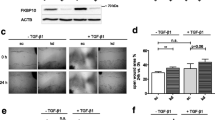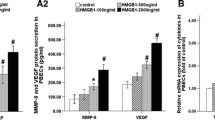Abstract
The migration of lung fibroblasts plays a pivotal role in wound repair and fibrotic processes in the lung. Although the receptor for advanced glycation end products (RAGE) has been implicated in the pathogenesis of lung diseases, its role in lung fibroblast migration is unclear. The current study examined the effect of three different RAGE ligands, namely, high mobility group box 1 (HMGB1), S100A12, and N-epsilon-(carboxymethyl) lysine (CML), on human fibronectin-directed human fetal lung fibroblast (HFL-1) migration. HMGB1 augmented, whereas S100A12 inhibited, HFL-1 migration in a concentration-dependent manner. CML did not affect HFL-1 migration. The effect of HMGB1 was not through RAGE. However, the effect of S100A12 was mediated by RAGE, but not Toll-like receptor 4. S100A12 did not exert a chemoattractant effect, but inhibited HFL-1 chemotaxis and/or chemokinesis. Moreover, S100A12 mediated HFL-1 migration through p38 mitogen-activated protein kinase (MAPK) but not through nuclear factor-kappa B, protein kinase A, phosphatase and tensin homolog deleted on chromosome 10, or cyclooxygenase. In addition, western blot analysis showed that S100A12 augmented p38 MAPK activity in the presence of human fibronectin. In conclusion, S100A12 inhibits lung fibroblast migration via RAGE-p38 MAPK signaling. This pathway could represent a therapeutic target for pulmonary conditions characterized by abnormal tissue repair and remodeling.





Similar content being viewed by others
References
Bianchi ME (2007) DAMPs, PAMPs and alarmins: all we need to know about danger. J Leukoc Biol 81:1–5
Bierhaus A, Humpert PM, Morcos M, Wendt T, Chavakis T, Arnold B, Stern DM, Nawroth PP (2005) Understanding RAGE, the receptor for advanced glycation end products. J Mol Med (Berl) 83:876–886
Buckley ST, Ehrhardt C (2010) The receptor for advanced glycation end products (RAGE) and the lung. J Biomed Biotechnol 2010:917108
Chen HC (2005) Boyden chamber assay. Methods Mol Biol 294:15–22
Chen L, Wang T, Guo L, Shen Y, Yang T, Wan C, Liao Z, Xu D, Wen F (2014) Overexpression of RAGE contributes to cigarette smoke-induced nitric oxide generation in COPD. Lung 192:267–275
Chung KF (2011) p38 mitogen-activated protein kinase pathways in asthma and COPD. Chest 139:1470–1479
Cockayne DA, Cheng DT, Waschki B, Sridhar S, Ravindran P, Hilton H, Kourteva G, Bitter H, Pillai SG, Visvanathan S, Muller KC, Holz O, Magnussen H, Watz H, Fine JS (2012) Systemic biomarkers of neutrophilic inflammation, tissue injury and repair in COPD patients with differing levels of disease severity. PLoS One 7:e38629
Decaestecker C, Debeir O, Van Ham P, Kiss R (2007) Can anti-migratory drugs be screened in vitro? A review of 2D and 3D assays for the quantitative analysis of cell migration. Med Res Rev 27:149–176
Ferhani N, Letuve S, Kozhich A, Thibaudeau O, Grandsaigne M, Maret M, Dombret MC, Sims GP, Kolbeck R, Coyle AJ, Aubier M, Pretolani M (2010) Expression of high-mobility group box 1 and of receptor for advanced glycation end products in chronic obstructive pulmonary disease. Am J Respir Crit Care Med 181:917–927
Hofmann MA, Drury S, Fu C, Qu W, Taguchi A, Lu Y, Avila C, Kambham N, Bierhaus A, Nawroth P, Neurath MF, Slattery T, Beach D, McClary J, Nagashima M, Morser J, Stern D, Schmidt AM (1999) RAGE mediates a novel proinflammatory axis: a central cell surface receptor for S100/calgranulin polypeptides. Cell 97:889–901
Ikari J, Michalski JM, Iwasawa S, Gunji Y, Nogel S, Park JH, Nelson AJ, Farid M, Wang X, Schulte N, Basma H, Toews ML, Feghali-Bostwick C, Tenor H, Liu X, Rennard SI (2013) Phosphodiesterase-4 inhibition augments human lung fibroblast vascular endothelial growth factor production induced by prostaglandin E2. Am J Respir Cell Mol Biol 49:571–581
Kessel C, Holzinger D, Foell D (2013) Phagocyte-derived S100 proteins in autoinflammation: putative role in pathogenesis and usefulness as biomarkers. Clin Immunol 147:229–241
Kikuchi K, Kohyama T, Yamauchi Y, Kato J, Takami K, Okazaki H, Desaki M, Nagase T, Rennard SI, Takizawa H (2009) C-reactive protein modulates human lung fibroblast migration. Exp Lung Res 35:48–58
Kim D, Haynes CL (2013) The role of p38 MAPK in neutrophil functions: single cell chemotaxis and surface marker expression. Analyst 138:6826–6833
Kohyama T, Ertl RF, Valenti V, Spurzem J, Kawamoto M, Nakamura Y, Veys T, Allegra L, Romberger D, Rennard SI (2001) Prostaglandin E(2) inhibits fibroblast chemotaxis. Am J Phys Lung Cell Mol Phys 281:L1257–L1263
Kohyama T, Liu X, Wen FQ, Kobayashi T, Fang Q, Abe S, Cieslinski L, Barnette MS, Rennard SI (2004) Cytokines modulate cilomilast response in lung fibroblasts. Clin Immunol 111:297–302
Kohyama T, Liu XD, Wen FQ, Kim HJ, Takizawa H, Rennard SI (2002) Prostaglandin D2 inhibits fibroblast migration. Eur Respir J 19:684–689
Lander HM, Tauras JM, Ogiste JS, Hori O, Moss RA, Schmidt AM (1997) Activation of the receptor for advanced glycation end products triggers a p21(ras)-dependent mitogen-activated protein kinase pathway regulated by oxidant stress. J Biol Chem 272:17810–17814
Lee CC, Wang CN, Lee YL, Tsai YR, Liu JJ (2015) High mobility group box 1 induced human lung myofibroblasts differentiation and enhanced migration by activation of MMP-9. PLoS One 10:e0116393
Li Y, Prasad A, Jia Y, Roy SG, Loison F, Mondal S, Kocjan P, Silberstein LE, Ding S, Luo HR (2011) Pretreatment with phosphatase and tensin homolog deleted on chromosome 10 (PTEN) inhibitor SF1670 augments the efficacy of granulocyte transfusion in a clinically relevant mouse model. Blood 117:6702–6713
Liang CC, Park AY, Guan JL (2007) In vitro scratch assay: a convenient and inexpensive method for analysis of cell migration in vitro. Nat Protoc 2:329–333
Nah SS, Choi IY, Lee CK, Oh JS, Kim YG, Moon HB, Yoo B (2008) Effects of advanced glycation end products on the expression of COX-2, PGE2 and NO in human osteoarthritic chondrocytes. Rheumatology (Oxford, England) 47:425–431
Neeper M, Schmidt AM, Brett J, Yan SD, Wang F, Pan YC, Elliston K, Stern D, Shaw A (1992) Cloning and expression of a cell surface receptor for advanced glycosylation end products of proteins. J Biol Chem 267:14998–15004
Park JS, Svetkauskaite D, He Q, Kim JY, Strassheim D, Ishizaka A, Abraham E (2004) Involvement of toll-like receptors 2 and 4 in cellular activation by high mobility group box 1 protein. J Biol Chem 279:7370–7377
Popovic PJ, DeMarco R, Lotze MT, Winikoff SE, Bartlett DL, Krieg AM, Guo ZS, Brown CK, Tracey KJ, Zeh HJ 3rd (2006) High mobility group B1 protein suppresses the human plasmacytoid dendritic cell response to TLR9 agonists. J Immunol 177:8701–8707
Queisser MA, Kouri FM, Konigshoff M, Wygrecka M, Schubert U, Eickelberg O, Preissner KT (2008) Loss of RAGE in pulmonary fibrosis: molecular relations to functional changes in pulmonary cell types. Am J Respir Cell Mol Biol 39:337–345
Raghow R (1994) The role of extracellular matrix in postinflammatory wound healing and fibrosis. FASEB J 8:823–831
Rennard SI, Jaurand MC, Bignon J, Kawanami O, Ferrans VJ, Davidson J, Crystal RG (1984) Role of pleural mesothelial cells in the production of the submesothelial connective tissue matrix of lung. Am Rev Respir Dis 130:267–274
Ridley AJ, Schwartz MA, Burridge K, Firtel RA, Ginsberg MH, Borisy G, Parsons JT, Horwitz AR (2003) Cell migration: integrating signals from front to back. Science 302:1704–1709
Schiraldi M, Raucci A, Muñoz LM, Livoti E, Celona B, Venereau E, Apuzzo T, De Marchis F, Pedotti M, Bachi A, Thelen M, Varani L, Mellado M, Proudfoot A, Bianchi ME, Uguccioni M (2012) HMGB1 promotes recruitment of inflammatory cells to damaged tissues by forming a complex with CXCL12 and signaling via CXCR4. J Exp Med 209:551–563
Schleicher ED, Wagner E, Nerlich AG (1997) Increased accumulation of the glycoxidation product N(epsilon)-(carboxymethyl)lysine in human tissues in diabetes and aging. J Clin Invest 99:457–468
Sorci G, Riuzzi F, Giambanco I, Donato R (2013) RAGE in tissue homeostasis, repair and regeneration. Biochim Biophys Acta 1833:101–109
Suganuma H, Sato A, Tamura R, Chida K (1995) Enhanced migration of fibroblasts derived from lungs with fibrotic lesions. Thorax 50:984–989
Togo S, Holz O, Liu X, Sugiura H, Kamio K, Wang X, Kawasaki S, Ahn Y, Fredriksson K, Skold CM, Mueller KC, Branscheid D, Welker L, Watz H, Magnussen H, Rennard SI (2008) Lung fibroblast repair functions in patients with chronic obstructive pulmonary disease are altered by multiple mechanisms. Am J Respir Crit Care Med 178:248–260
van Beijnum JR, Buurman WA, Griffioen AW (2008) Convergence and amplification of toll-like receptor (TLR) and receptor for advanced glycation end products (RAGE) signaling pathways via high mobility group B1 (HMGB1). Angiogenesis 11:91–99
White ES, Atrasz RG, Dickie EG, Aronoff DM, Stambolic V, Mak TW, Moore BB, Peters-Golden M (2005) Prostaglandin E(2) inhibits fibroblast migration by E-prostanoid 2 receptor-mediated increase in PTEN activity. Am J Respir Cell Mol Biol 32:135–141
White ES, Thannickal VJ, Carskadon SL, Dickie EG, Livant DL, Markwart S, Toews GB, Arenberg DA (2003) Integrin alpha4beta1 regulates migration across basement membranes by lung fibroblasts: a role for phosphatase and tensin homologue deleted on chromosome 10. Am J Respir Crit Care Med 168:436–442
Wilkinson PC (1998) Chemotaxis. In: Delves PJ (ed) encyclopedia of immunology, 2nd edn. Elsevier, Oxford, pp 533–537
Xie J, Mendez JD, Mendez-Valenzuela V, Aguilar-Hernandez MM (2013) Cellular signalling of the receptor for advanced glycation end products (RAGE). Cell Signal 25:2185–2197
Yonchuk JG, Silverman EK, Bowler RP, Agusti A, Lomas DA, Miller BE, Tal-Singer R, Mayer RJ (2015) Circulating soluble receptor for advanced glycation end products (sRAGE) as a biomarker of emphysema and the RAGE axis in the lung. Am J Respir Crit Care Med 192:785–792
Zhu J, Yang K, Jing Y, Du R, Zhu Z, Lu L, Zhang R (2012) The effects of low-dose nepsilon-(carboxymethyl)lysine (CML) and nepsilon-(carboxyethyl)lysine (CEL), two main glycation free adducts considered as potential uremic toxins, on endothelial progenitor cell function. Cardiovasc Diabetol 11:90–90
Acknowledgments
The authors would like to thank Dr. Takayuki Jujo, Ms. Tomoko Misawa, Ms. Ikuko Sakamoto, and Ms. Akiko Moriya for the experimental assistance, and Ms. Chieko Handa, Ms. Tamie Hirano, and Ms. Mika Sakurai for the secretarial assistance.
Funding
This research was supported by grants from JSPS KAKENHI (grant number 17K09646) and GSK Japan Research Grant 2016 (grant number A-35).
Author information
Authors and Affiliations
Corresponding author
Ethics declarations
Conflict of interest
The authors declare that they have no conflicts of interest.
Additional information
Editor: Tetsuji Okamoto
Rights and permissions
About this article
Cite this article
Tanaka, N., Ikari, J., Anazawa, R. et al. S100A12 inhibits fibroblast migration via the receptor for advanced glycation end products and p38 MAPK signaling. In Vitro Cell.Dev.Biol.-Animal 55, 656–664 (2019). https://doi.org/10.1007/s11626-019-00384-x
Received:
Accepted:
Published:
Issue Date:
DOI: https://doi.org/10.1007/s11626-019-00384-x




